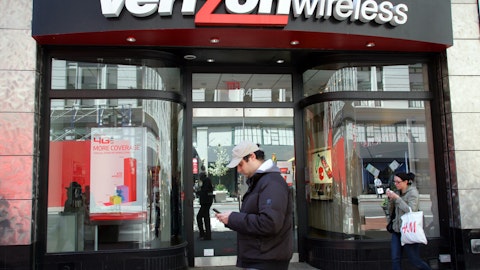Verizon Communications Inc. (NYSE:VZ) Q3 2023 Earnings Call Transcript October 24, 2023
Verizon Communications Inc. beats earnings expectations. Reported EPS is $1.22, expectations were $1.17.
Operator: Good morning, and welcome to the Verizon Third Quarter 2023 Earnings Conference Call. At this time, all participants have been placed in a listen-only mode and the floor will be opened for questions following the presentation. [Operator Instructions] Today’s conference is being recorded. If you have any objections, you may disconnect at this time. It is now my pleasure to turn the call over to your host, Mr. Brady Connor, Senior Vice President, Investor Relations.
Brady Connor: Thanks, Brad. Good morning, everyone, and welcome to our third quarter earnings conference call. I’m Brady Connor, and I’m joined by our Chairman and Chief Executive Officer, Hans Vestberg, as well as our Chief Financial Officer, Tony Skiadas. Before we begin, I’d like to draw your attention to our Safe Harbor statement which can be found on Slide 2 of the presentation. Information in this presentation contains statements about expected future events and financial results that are forward-looking and subject to risks and uncertainties. Discussions of factors that may affect future results is contained in Verizon’s filings with the SEC which are available on our website. This presentation contains certain non-GAAP financial measures.

A Wall Street trader on the phone, quickly executing a technology-driven trade. Editorial photo for a financial news article. 8k. –ar 16:9
Reconciliations of these non-GAAP measures to the most directly comparable GAAP measures are included in the financial materials posted on our website. Earlier this morning, we posted to our Investor Relations website, a detailed review of our third quarter results. You will find additional details in the earnings materials on our Investor Relations website. With that, I’ll turn the call over to Hans.
Hans Vestberg: Thank you, Brady, and good morning, to everyone. I am pleased to share our strong third quarter results making out the quarter with solid growth and improving profitability. It is clear that our strategy is working. In both the consumer and the business groups we are executing a segmented agile strategy that provides value to our customers and our bottom-line. We have delivered growth in each of areas where on, wireless service revenue, EBITDA and free cash flow. This is evidence that we have the right strategy and are achieving our results in a financially disciplined way. Now let me share our financials for the quarter. For the third quarter, wireless service revenue is up 3.9% year-over-year, driven by expanding and deepening our customer relationships.
This revenue growth is a key driver for adjusted EBITDA of $12.2 billion for the quarter which is higher than both Q3 last year and sequentially. Our year to-date free cash flow of $14.6 billion is already exceeding our full year free cash flow for 2022. Thanks to our focus on high quality revenue growth, disciplined promotion strategy, cost efficiency and CapEx reduction of the recent years of heightened capital-intensity driven by the C-band, and fiber investments. I’m proud to share that my team and I have taken actions to further our position our financial strengths. Our strong cash generation enabled us to reduce net debt, strengthen our balance sheet, and deliver a higher dividend to our shareholders. We’re working to bring our leverage ratio to the pre-Spectrum acquisition levels.
During the third quarter, we paid down $2.6 billion in debt and increased our dividend for the 17th consecutive year. A current industry record that we take pride in. Our dividend coverage is very healthy. Year to-date our free cash flow dividend payout ratio is approximately 56%, a significant improvement from a year ago. In summary, in spite of an uncertain economic environment, we are on pace to finish 2023 strong. We are confident that we will deliver on the financial guidance that we issued to you at the start of the year and this morning are announcing higher free cash flow guidance for 2023. Tony will provide you more details in the few moments. Now, let me share more on how our business units are driving our strategy forward. In the quarter, we delivered on our key growth areas, mobility, broadband and private networks.
Thanks to our networks, scale and technology advantages. In consumer mobility, we achieved sequential and year year-over-year improvement in postpaid phone net adds by continuing to put the customer at the center everything we do rather than engaging in aggressive promotional activity like others in the industry, we’re offering our consumers optionality and flexibility to choose how they want to use our products and services. Our differentiated approach or segmentation, financial discipline is paying off with growth in postpaid phone growth adds and lower promotional cash costs. There is more work to be done, but our responsible approach position us to grow subscribers profitably. Since its launch in May, myPlan continues to deliver a personalized experience, giving our customers the value, choice and control that they want.
During the third quarter,we enhanced myPlan by adding Ultimate Unlimited, a third tier with more value and services, further increasing our premium mix and ARPA growth. This is just one example of the flexibility and speed to market that myPlan provides. And I’m excited about what is to come. Our targeted and segmented market approach also serves as well during the iPhone 15 launch and we continue to execute with an iTunes meeting our customers’ needs while maintaining a disciplined approach. Our competitive position is now stronger. And we’ve delivered positive consumer postpaid phone net adds in the month of September. We anticipate that momentum will continue as we are on track to exceed our postpaid phone net adds from Q4 of last year.
Postpaid phone shown levels are stable even with our targeted pricing actions throughout the year. We continue to see muted upgrade levels, which is something we are watching carefully and is a trend we expect will continue for the next few quarters. Turning to business mobility. Verizon Business Group delivered 151,000, phone net ads and reached our ninth consecutive quarter above 125,000. Business in governments continue place an increased emphasis on best-in-class reliable connectivity that only Verizon provides. Across mobility, postpaid phone net adds were 100,000, compared to 8,000 last year. We have the largest customer base in the industry and are still finding new ways to add customers through innovation, service quality and a variety of offerings and partnerships that competitors cannot match.
As we discussed before, we’re seeking the optimal balance between price and quantity that allow us to grow our base profitability. In our value business we have had negative volumes, but I’m encouraged by our quarter-over-quarter improvements. As I’ve said before, the value business is a key part of our growth strategy, and we will continue to invest in it and adjust to the needs of the markets. As we mentioned last quarter, we believe we’re seeing the bottom for prepaid volumes and the team is committed and working daily to grow our value business. Moving to broadband, we delivered another strong quarter with more than 400,000 new subscribers for the fourth quarter in a row. We finished Q3 with $10.3 million broadband subscribers, up by more than 1.7 million subscribers from a year ago, a 21% increase.
Critical to the strengths of this key area is fixed wireless access, something you know we deeply believe in. Our fixed wireless access net adds of 384,000 continue to be strong even with a recent $10 increase for new bundled customers, further evidence of the demand for our product. Where FWA is available, our customers take it and loving it as seen by the high net promoter score. I’m excited towards the share that on the Fios side we had 72,000 Internet net adds for the quarter, up, almost 20% year-over-year and one or best performances in seven years. Fios remains a coveted, high quality service and we continue to take share and deliver strong numbers even in a lower mover environment. When it comes to private networks, we demand for the product continue to grow, especially those solutions built with licensed spectrum, which provides a more secure and differentiated experience for the end-users.
Businesses are increasingly looking to us for the private network solutions helping to grow our sales funnel and scale the number of installations each quarter. Let me end by talking about the backbone of our business, our network. During the third quarter, we obtained early access to our remaining C-band spectrum. In urban markets, where C-band is already deployed, we’re firing on all cylinders and leveraging its full potential through software upgrades, delivering two to three times more spectrum depth. As a result, peak speeds go from 9 megabits per second to an amazing 2.4 gigabits per second enabling an even better experience for our customers. You’ve heard me say this before, but let me say it again. C-Band is a game change for our business, giving us better customer attention and step up, as well as a strong broadband opportunity with fixed wireless access.
Every day we see the benefits of our generation investment in C-band spectrum and the impact it will have for our customers for years to come. And our network is winning. This quarter, we received J.D. Power awards in all six US regions, receiving the most awards for wireless network quality for the 31st time in a row. We have the best networks in the market and we will extend our lead as we complete our C-band deployment, first augmenting urban areas, and next year in suburban and rural markets. This is our key differentiator and the center of everything we do. And we’re doing all of this in a responsible way. We’re optimizing our network while returning to business as usual levels of CapEx. We’re finding cost efficiencies across our business both as a result of our a new structure, and by emphasizing profitability, when evaluating new opportunities like within business wireline.
Our cost efficiency program remains on track to meet our savings goal of $2 billion to $3 billion annually by 2025. Now let me turn the call over to Tony to discuss our financial and operational performance in more detail.
Tony Skiadas: Thanks, Hans and good morning. Our results for the third quarter continue to demonstrate our progress towards our three priorities, growing wireless service revenue, and driving EBITDA and free cash flow. As Hans said, we are executing on our plan and remain on track to meet our financial guidance for 2023. We’ve talked about improving our operational performance while maintaining financial discipline with the third quarter results representing another proof point that demonstrates we can deliver improving key metrics and strong financials. Consumer postpaid phone net losses totaled $51,000 for the quarter, an improvement of $85,000, sequentially and $138,000 compared to the prior year. During the quarter, we executed well in a low switcher environment, enabling postpaid phone gross add growth of 2.3% year-over-year.
Our postpaid phone churn of 0.85% represents a stable result even after implementing over $1 billion of annualized pricing actions in 2023. Our segmented approach to the market and the structure and discipline of our promotional strategy helped to deliver strong postpaid phone gross adds and lower postpaid upgrades. The third quarter’s consumer upgrade rate of 3.6% is down 150 basis points year-over-year. The quality of the business we are writing in consumer remains high as myPlan continues to drive an elevated premium mix. Consumer ARPA of $133.47 increased sequentially by 1.2% and year-over-year by 4.5%. We expect to deliver further ARPA growth as a result of the innovations of myPlan, as well as our most recent pricing actions. Verizon Business delivered another strong quarter with 151,000 phone net adds, which as Hans mentioned is our ninth consecutive quarter above 125,000.
While the macroeconomic environment is uncertain and businesses are more cautious than a year ago, mobility continues to be a top investment priority for our Business customers. We expect to continue to deliver strong volumes and expand their relationships by leveraging our position as the wireless market share leader for small and medium businesses, large enterprises and public sector customers. Moving on to broadband, we delivered 434,000 net additions continuing the pace of over 400,000 net adds for the fourth quarter in a row. Customers are drawn to the quality of our service and overall value proposition for both FWA and Fios. For fixed wireless, gross add expansions grew 384,00 net adds for the quarter growing the base to nearly 2.7 million subscribers.
The addition of the second tranche of C-band spectrum will help us continue our FWA momentum as we work to build a long-term sustainable business. Fios Internet net adds were 72,000, up 11,000 year-over-year. We are pleased with the success of FiOS with strong gross adds and retention reflecting the quality and overall value of the product. For prepaid, net loss is up $207,000 represents the sequential improvement from the second quarter. We expected a better trajectory for the remainder of the year, as the teams continue to scale some of our key brands such as Visible, and Total by Verizon and execute on our ongoing integration efforts. Let’s now look at our financials. Consolidated revenue for the third quarter was $33.3 billion, down 2.6% year-over-year.
The decline can be attributed to wireless equipment revenue, which was approximately 12% lower than the prior year as postpaid upgrades declined 26%. Total wireless service revenue was $19.3 billion, up 2.9% year-over-year and up $217 million sequentially. Strong revenue benefited from targeted pricing actions, more customers selecting premium unlimited plans and growth and fixed wireless access. Additionally, as a result of our discipline around promotions and lower upgrade volumes, we saw further reduction in headwinds to service revenue growth associated with promo amortization. This was partially offset by pressure from prepaid, which reduce total wireless service revenue growth by approximately 60 basis points year-over-year. Consolidated adjusted EBITDA in the quarter was $12.2 billion, an increase of $267 million sequentially and up 0.2%, compared to the prior year.
Adjusted EBITDA margin improved by 100 basis points year-over-year, primarily driven by improved wireless service revenue and lower consumer postpaid upgrades. Operating expenses, excluding depreciation and amortization and special items were down approximately 4% year-over-year, primarily due to the lower cost of equipment from reduced upgrade volumes. While bad debt is up year-over-year, it was once again flat sequentially consistent with the first half of the year. We continue to make progress on our cost efficiency program, having recently implemented transformations within our consumer, customer care group, as well as business manage services. We are on track to deliver $200 million to $300 million of savings in 2023 building momentum to generate incremental savings in 2024.
Adjusted EPS was $1.22 and includes $0.03of pressure from a reduction in capitalized interest due to the early clearance of C-band spectrum. We currently anticipate another incremental $0.03 to $0.04 in the fourth quarter. Turning the attention to cash flow. Cash flow from operating activities for the third quarter was $10.8 billion, bringing the 2023 year-to-date total to $28.8 billion. The year-to-date performance is up approximately $600 million compared to the prior year, primarily due to working capital improvements associated with fewer upgrades and lower inventory levels partially offset by higher interest payments. Customer payments continue to be healthy with consistent performance throughout the year. CapEx for the quarter came in at $4.1 billion, totaling $14.2 billion year-to-date.
At this point, we expect 2023 CapEx to come in at the upper end of our guidance range of $18.25 billion to $19.25 billion. The third quarter was a second consecutive quarter operating at our business as usual runrate. As a result, we would expect a reduction of approximately $4 billion of CapEx in 2023, compared to the prior year. Free cash flow for the third quarter was $6.7 billion, bringing our year-to-date total to $14.6 billion, a $2.2 billion improvement over the prior year. As Hans mentioned, we have generated more free cash flow in the first three quarters of this year than in all of 2022. Based on our year-to-date results and the strength of our core business, we are pleased to raise our 2023 free cash flow guidance by $1 billion to more than $18 billion.
We are raising guidance even with CapEd at the upper end of our range and absorbing the headwinds from interest expense. Strong free cash flow provides flexibility and enables us to deliver on our capital allocation priorities. As Hans said, within the third quarter, we executed a successful $2.6 billion debt tender, of which a majority was floating rate, while also increasing our dividend once again. Additionally, given our cash position and the performance of the business, this month we paid approximately $3.7 billion of spectrum clearing cost, primarily using operating cash flow. The remaining spectrum payments are minimal and will be made in 2024. Net unsecured debt at the end of the quarter was $122.2 billion, an improvement of $4.3 billion from the end of second quarter, and $7.1 billion lower year-over-year.
We ended the quarter with $4.2 billion of cash on hand, which we are using to pay the clearing cost I just described. Our net unsecured debt to consolidated adjusted EBITDA ratio was 2.6 times as of the end of the third quarter, representing a 0.1, churn improvement year-over-year. Overall, I’m pleased with our ability to deliver stronger operational and financial trends. We are focused on finishing the year strong with continued improvements in volumes and financials, setting us up for meaningful deleveraging opportunities in 2024. I will now turn the call back to Hans for his closing thoughts before we open it up to your questions.
Hans Vestberg: Thank you, Tony. I’m proud of the progress our team has made and our operating results over the last three quarters should also give you confidence in us. We’re delivering on our financial targets ahead of schedule on several key metrics and are restoring our leverage ratios to where we want them to be. We have a great network and our free cash flow generation is industry leading and we have more than 10 million broadband subscribers and that number is growing at near record rates. As we enter the final quarter of 2023, our goals are clear; deliver strong growth in wireless service revenue; EBITDA and free cash flow. Our segmented and disciplined approach to consumer mobility is working and we expect our momentum to continue building in the fourth quarter.
Enabling all of this is America’s best and most reliable 5G networks. Or C-band spectrum has already benefited mobility and broadband. Deploying the remaining C-band will make this network even stronger and more resilient and I’m excited about the opportunities that lies ahead. Let me close with this. Our performance has put us firmly on track to meet our full year financial targets and position us well as we approach 2024. We’re excited to head into 2024 with all of our assets in place and a great team to execute our strategy. With that, I hand the call back to Brady for questions.
Brady Connor: Thanks, Hans. Brad, we are ready to take questions this morning.
See also 20 Highest Paying Countries for Doctors and 30 Countries That Export The Most Weapons in the World.
Q&A Session
Follow Verizon Communications Inc (NYSE:VZ)
Follow Verizon Communications Inc (NYSE:VZ)
Operator: Thank you. [Operator Instructions] And the first question for today will come from Phil Cusick of JP Morgan. Your line is open, sir.
Phil Cusick: Hi guys. Thank you. Two if I can. Tony, how should we think about the pieces of free cash flow growing our stability next year? And after making the C-band relocation payments, what obligations other than the dividend will prevent you from delivering? And then Hans as a follow-up, there’s a lot of speculation about M&A in the fiber and wireless spaces lately. Can you talk about any interest you have in buying fiber or wireless assets in the market? And if so, what might be criteria for that? Thank you.
Hans Vestberg : I will start and I hand it over to Tony. I mean, first on the cash flow, I think you have seen us now the last couple of years are focusing very much on our service revenue expansion, EBITDA and cash flow expansion and all our incentives for the management deceptive from the Board, both short and long term. So this is a key thing for us to see that we are continuing to generate a lot of cash flow. Tony will take – talk to the puts and takes. Regarding fiber adds, and first of all I love our strategy. I mean our strategy was clear from 2017. In the Fios footprint of course we build a lot of fiber doing extremely well. You saw this quarter again a record quarter of Fios subscribers. Outside we build one fiber over a couple of years.
We’re basically in all the major markets. We have one fiber to our own network. Right now, our strategy is clear that we want to take the broadband subscribers with fixed lines access because we get them right now. It’s a superior product and we don’t see a need right now for adding any fiber to that footprint. Over time, of course, we will always look into it and anyone that would dispose any telecommunication assets, any market will talk to us, but the total is high. I mean, we have a great network and we have built a really good strategy around our technology.
Tony Skiadas : Hi Phil. Good morning. So on the cash generation, so we’re very pleased thus far. I’ll start with where we are in the third quarter. So we’re pleased with the cash generation of the business. The performance of the business, and as you saw the continued discipline that we had with promos and retention gave us the confidence to raise the free cash flow guide by $1 billion to more than $18 billion. And that’s with CapEx at the upper end of the range and also with higher interest expense. So we feel very good about the balance of the year and are positioning heading into next year. Obviously, we’re not going to guide on 2024 at this time, but I can share some qualitative aspects as we look ahead to free cash flow for 2024.
On the plus side, we continue to focus the team on an improving EBITDA profile and that’s a big focus of the team. With respect to CapEx, we said a couple of times here in the past that we expect to run at $17 billion to $17.5 billion for 2024, which is back to a business as usual level of spend that you’ve seen from us. And then we also strive to make continued improvements in working capital. And then offsetting that, we expect higher interest costs from both in the rate environment and the reduction in capitalized interest due to the early clearing of the C-band spectrum. And then with taxes, as you know, under current legislation, taxes are going to be pressured by the continued phase out of bonus depreciation and we’ll see how that plays out.
And, so heading into 2024, we continue to focus on strong free cash flow generation and opportunities for meaningful debt reduction. And we don’t see any obstacles of Delevering. Thanks. Okay guys.
Brady Connor: Yeah, great. Thanks. Thanks Phil, Brad. We’re ready for the next question.
Operator: The next question comes from Simon Flannery of Morgan Stanley. Your line is open sir.
Simon Flannery: Great. Thank you very much. Good morning. Hans, you talked a lot about fixed wireless. You’ve got the rest of the C-band. Can you help update the fixed wireless footprint? The open for sale and where you are today? And how you get to the $50 million households or any updated target that you have there? And then, Tony, you talked a little bit about some of the pricing actions you’ve taken so far. Can you just cheese out for us what you’ve recognized in Q3? And what I think you’ve talked about a tailwind when going into Q4. So, how we think about some of the, the kind of sequential benefits that are still to come? Thank you.
Hans Vestberg : Simon, I can start with fixed wireless access. As you can see, we continue on that rhythm with the 354, 000 every quarter. The additional C-band we got, used a couple of weeks ago we initially go straight to augmenting our urban areas. We’ve already had the sites and then in the early part of next year, we will also start deploying that in suburban and rural areas. And of course, that’s an even greater opportunity for us because there are more underserved markets and our fixed wireless actually come extremely quickly into those markets. So that’s will just fortify our situation and how we want to roll this out. We have a target of $4 million to $5 million subscribers by 2025. We keep that of course, we have dimension on network for way more and the team, of course, have a have the internal targets that were set by me.
But right now, there’s nothing else that we want to deliver this target as well to the market. We always want to deliver what we tell the market and we’re going to do that. And then we have a conversation about that when we’ve passed it.
Tony Skiadas : And Simon, on the – on your question on pricing. So a few things here. We executed a number of pricing actions as you saw. The legacy mix and match that we did earlier in September will yield about a $100 million of incremental benefit in the in the fourth quarter and we also see improving volumes on mobility and year-over-year improvements there. And we also see a an increasing contribution for fixed wireless access. You saw the growth we had in the quarter with 384,000 net adds. We have 2.7, almost 2.7 million subs in our base. So we feel very good about the momentum there. So, very good progress on service revenue and setting us up well for next year.
Simon Flannery: Right. Thanks a lot.
Brady Connor: Brad, we are ready for the next question.
Operator: The next question comes from John Hodulik of UBS. Your line is open sir.
John Hodulik: Great. Thanks. Good morning guys. Just two questions. First on the upgrades. Obviously, that number continued to come down or solidly into this sort of 3% range. I mean, Hans, in you’re prepared remarks you sort of suggested that you expect to see the same for the next few quarters. I guess, two questions there. First of all, what in your view, what is really driving it? And do you think that this is a temporary issue or and that, it’ll go back to some sort of normalized rate? And then, any comments on what that low rate is really doing to your business? And then, secondly, in the past, you guys have given some numbers, and some metrics on what the C-band is doing for your business as it gets rolled out. Any update there? Are you still seeing improvement in things like gross adds, ARPU, Churn as you roll C-band out? Thanks.





